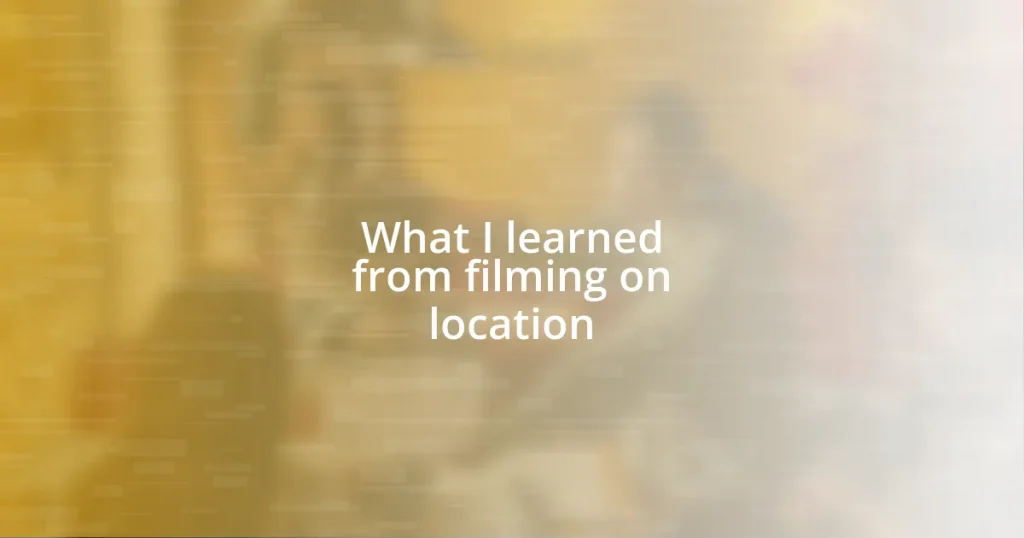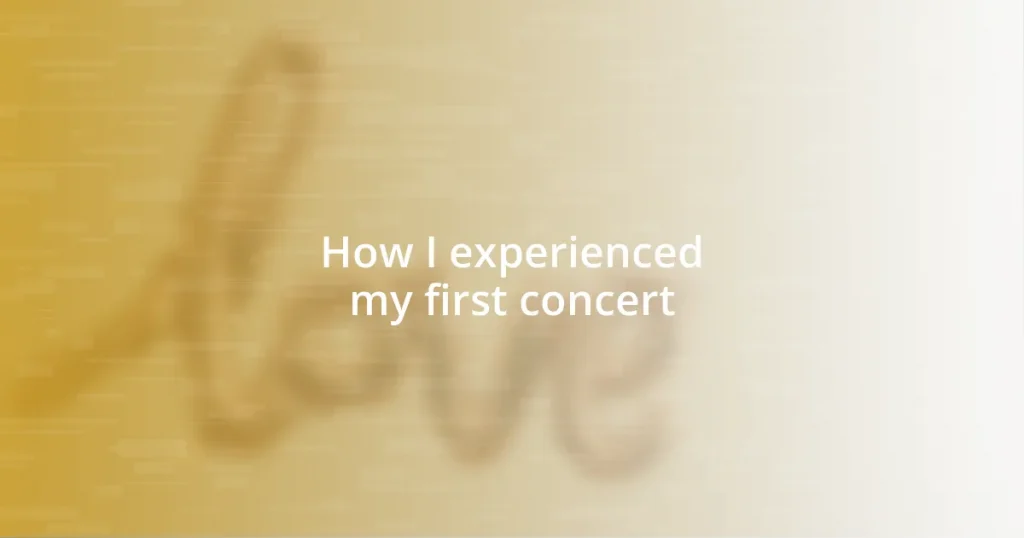Key takeaways:
- Filming on location enhances authenticity and enriches storytelling by embedding real-world contexts into narratives.
- Challenges such as acquiring permissions, weather unpredictability, and logistical complexities can foster teamwork and creativity.
- Effective planning, clear communication, and adaptability are crucial for successful location shoots.
- Understanding the unique energy of a location can inspire creativity and improve emotional connection in the final production.
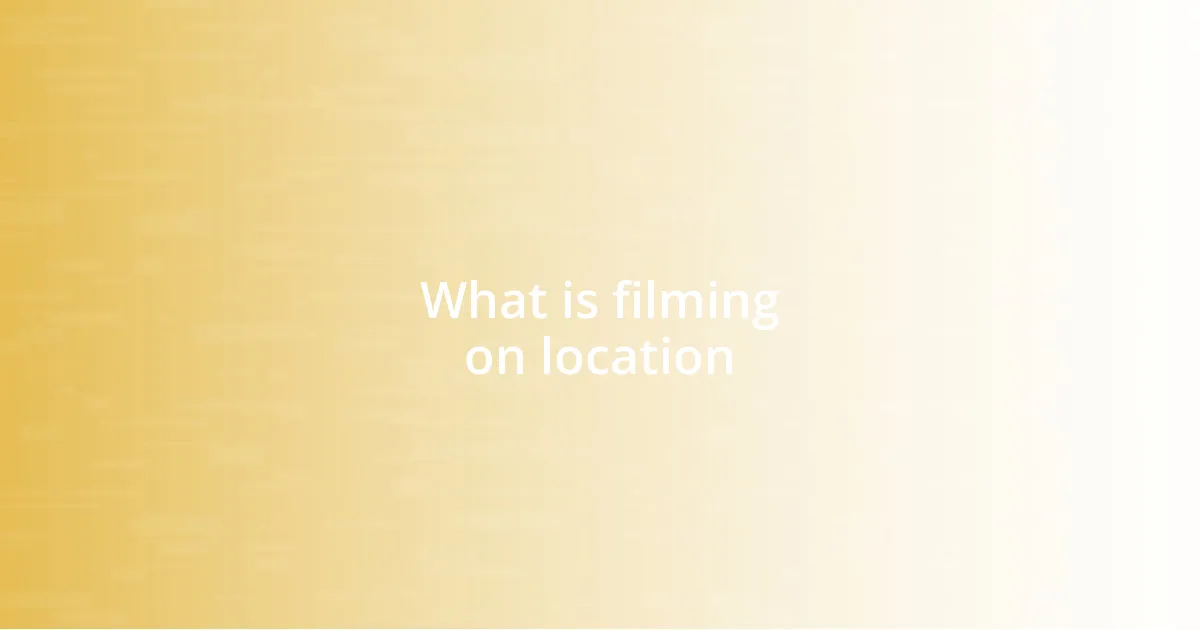
What is filming on location
Filming on location refers to shooting a film or television series at real-world sites rather than in a studio. There’s something magical about capturing the essence of a place—every street corner, mountain range, or bustling café adds layers of authenticity to a production. I remember the thrill of shooting in a quaint seaside town; every backdrop was steeped in history, and it truly transformed our story.
When I embarked on my first location shoot, the sound of seagulls and waves crashing provided the perfect ambient soundtrack. It was fascinating to see how the natural light played differently throughout the day, creating moods that set the tone for our scenes. Have you ever wondered how location impacts storytelling? It’s incredible to feel that connection between the setting and character development, as if the environment itself becomes a character.
Every location comes with its own challenges—permissions, weather, and logistics can be daunting. Yet, I found that these challenges often fostered teamwork and creativity among the crew. I vividly recall a rainstorm forcing us to adapt our plans; instead of feeling defeated, we turned the downpour into a pivotal scene, capturing genuine emotions that only a real environment could evoke.
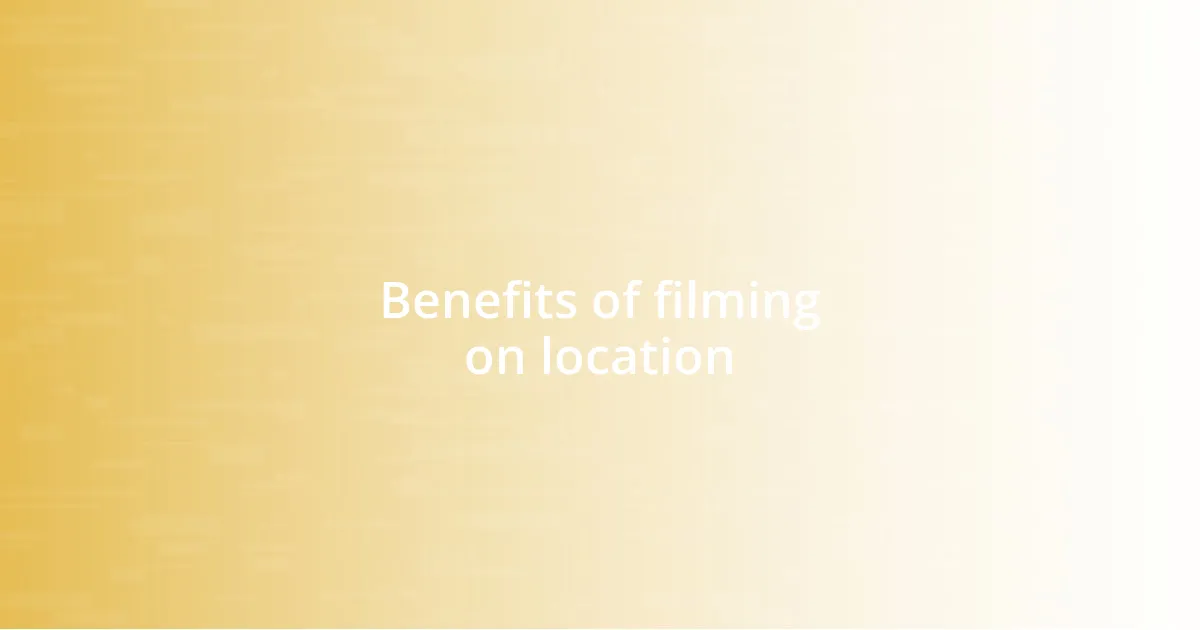
Benefits of filming on location
When filming on location, the benefits extend beyond just aesthetics. One of the most profound advantages I’ve experienced is the natural authenticity it brings to the storytelling process. I recall filming in a dense forest where the sun filtered through the trees, casting enchanting shadows. This setting not only enhanced the visual appeal but also allowed the actors to truly immerse themselves in their roles. The emotional nuances they portrayed felt more genuine, as if the environment itself was inviting them into the character’s journey.
Here are some key benefits of filming on location:
- Authenticity: Real settings convey a sense of truth that studio sets often lack.
- Atmosphere: Unique locations add distinct moods that enrich storytelling.
- Creative Inspiration: Unexpected elements in a location can spark new ideas and scenes.
- Unexpected Moments: Nature can create spontaneous opportunities, like capturing unplanned interactions or weather events.
- Local Culture: Filming in a community introduces cultural elements that enhance narrative depth.
Filming on location indeed opens up a world of possibilities, and I always look forward to the surprises it brings. The thrill of Oscar-winning sunsets or bustling marketplaces becomes a memorable part of the filmmaking process, impacting both the crew and the viewers in profound ways.
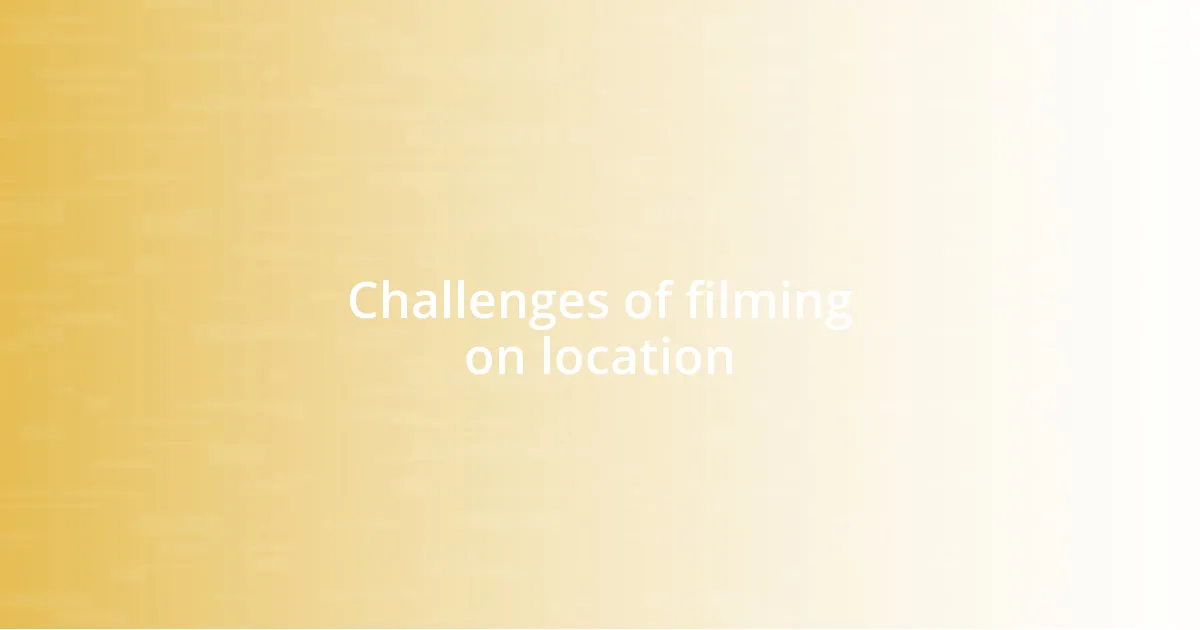
Challenges of filming on location
Filming on location can present a myriad of challenges—one that stands out is the struggle with acquiring permissions. I recall a particular shoot where we spent weeks securing agreements from local authorities, only to face last-minute changes due to unforeseen restrictions. This taught me that flexibility and open communication are vital. I often remind myself that patience becomes an essential asset in navigating these hurdles.
Then there’s the ever-unpredictable weather. During a shoot on a bustling city street, a sudden windstorm turned our planned day into a scramble for covers and gear. In that moment, I learned the value of contingency planning. It’s crucial to have backup shots and alternative plans ready, as nature tends to have its own agenda. Isn’t it ironic how what feels like an obstacle can often turn into a creative opportunity?
Lastly, the logistical challenges of transporting equipment and crew cannot be overstated. I once worked on a production at a remote mountain location, where the only road access was filled with twists and turns. Carrying heavy gear over rough terrain taught me about teamwork and coordination in a way no studio shoot ever could. Encountering these hurdles reminded me that overcoming challenges can strengthen the bond within the crew and spark innovative solutions.
| Challenge | Description |
|---|---|
| Permission Issues | Securing legal access can be time-consuming and complex. |
| Weather Conditions | Unpredictable weather can disrupt schedules and require quick adaptations. |
| Logistical Complexities | Transporting equipment and personnel to remote locations is often a logistical puzzle. |
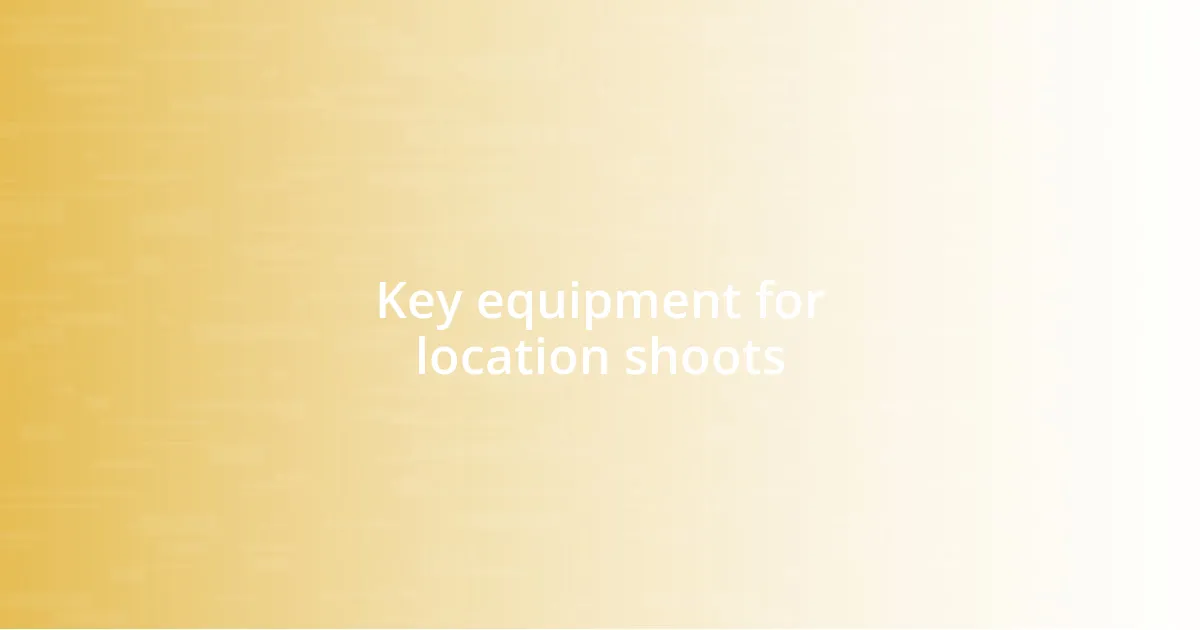
Key equipment for location shoots
When it comes to equipment for location shoots, a reliable camera is your best friend. I remember a time when I relied on a compact mirrorless camera for an intimate scene in a quaint café. It was lightweight, maneuverable, and allowed me to capture the emotion without being intrusive. Isn’t it fascinating how the right gear can influence the atmosphere of a shoot so dramatically?
Stabilization tools are equally essential. For instance, during a recent shoot along a rocky coastline, I used a gimbal to keep my shots steady while navigating uneven terrain. I could feel the waves crashing behind me, and I was grateful for that equipment; it allowed me to focus on storytelling rather than worrying about shaky footage. Have you ever considered how much a stable shot can enhance the viewer’s experience?
Don’t forget about sound equipment—especially on location. For one project, I underestimated the importance of using a high-quality shotgun microphone while filming in a busy marketplace. The ambient noise was so overwhelming that I realized I needed to invest in better gear. It’s moments like these that taught me how sound can create a powerful connection to the narrative. Have you found yourself in a similar situation, only to realize how crucial good audio is for the essence of a scene?
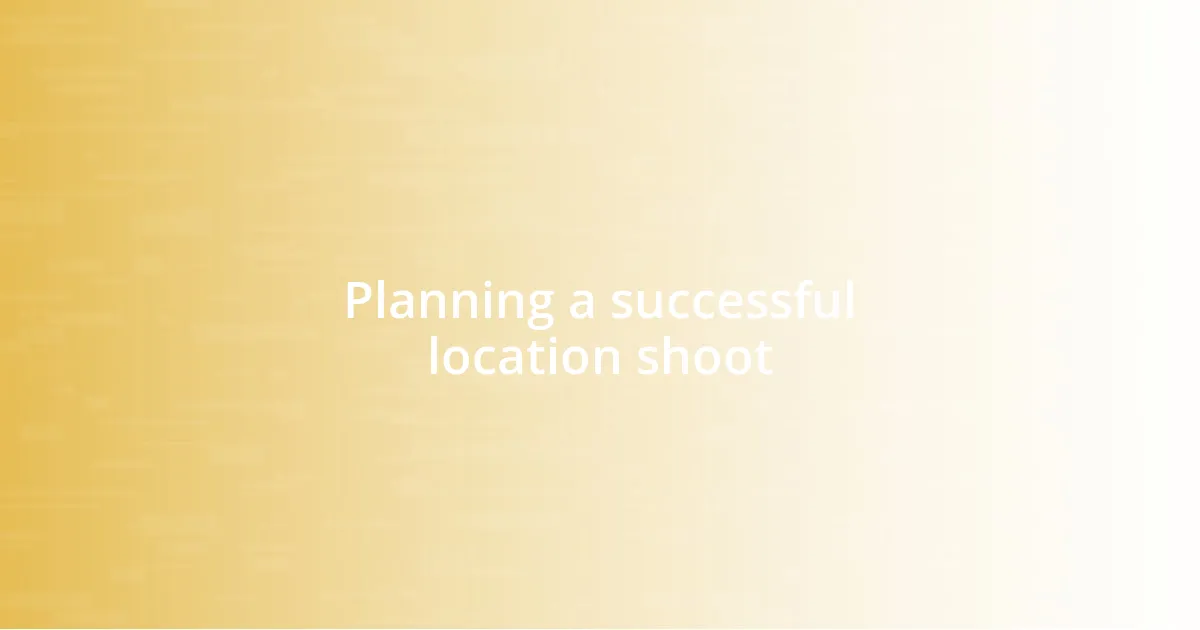
Planning a successful location shoot
Planning a successful location shoot begins with thorough research. I learned this the hard way after arriving at a site only to discover that it wasn’t as picturesque as it appeared in photos. By visiting the location beforehand and doing a little reconnaissance, I now ensure that each spot aligns perfectly with my vision. It’s all about painting a vivid picture in my mind before I even unpack the gear.
Creating a detailed shoot schedule is another critical step. I still remember a chaotic day when we underestimated the time needed for setting up equipment in a busy park. The clock ticked down, and I found myself racing against time while trying to secure the perfect angles. Since then, I’ve adopted a rule: allocate more time than you think you’ll need and build in breaks for crew morale. It’s surprising how a little extra time can improve the quality of work and the overall experience.
Don’t underestimate the power of having a solid team on the ground. During my early days, I often tried to do everything myself, thinking I could manage it all. But I later realized that collaboration is key. Empowering team members to take charge in their areas not only alleviates stress but also fosters a creative environment. Have you ever considered how a diverse group of perspectives can elevate your work? I surely have, and it’s made all the difference in my projects.
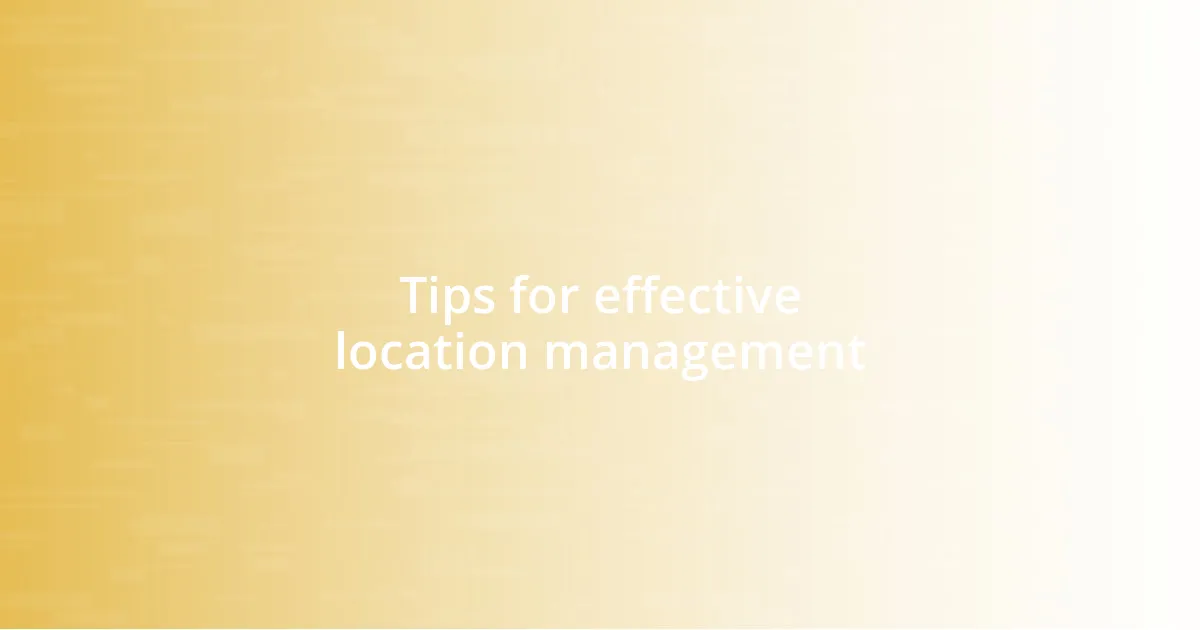
Tips for effective location management
Effective location management hinges on clear communication with your team and stakeholders. I once found myself in a bustling urban setting where directions weren’t properly relayed, leading to chaos at the start of the shoot. It felt overwhelming, like trying to catch smoke with my bare hands. Now, I always ensure that everyone understands their roles and coordinate daily briefings ahead of the shoot. Have you ever noticed how much smoother things go when everyone is on the same page?
One crucial aspect I’ve learned is to maintain flexibility in your plans. During a shoot in a picturesque forest, we encountered unexpected rain. It was frustrating, yet it pushed me to think creatively. We shifted our focus to capturing the moody atmosphere created by the rain, leading to some stunning shots that added depth to our story. Embracing change instead of resisting it can truly spark inspiration. Have you ever turned a challenge into an opportunity?
Finally, keeping a close eye on local regulations is vital for smooth operations. Embarking on a shoot in a public space without the proper permits can result in costly interruptions or even the end of your project before it starts. I once had to pack up everything mid-scene because of a surprise visit from city officials. It was disheartening, but that experience taught me to always double-check local rules well in advance. What have you found to be the most important thing to remember when juggling permits and permissions?
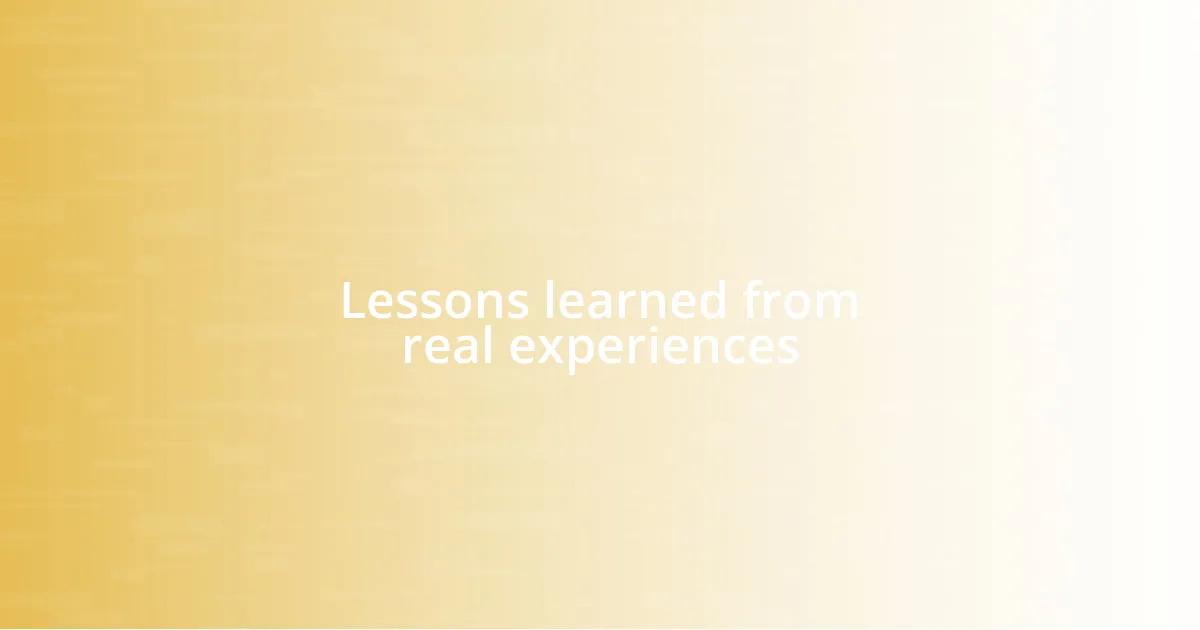
Lessons learned from real experiences
Filming on location has taught me that adaptability is essential. During one shoot at a historic site, we faced sudden noise from a construction crew that hadn’t been scheduled to work that day. I could feel frustration creeping in, but rather than allowing it to derail us, we adjusted our shots and incorporated the unexpected sounds into our narrative. Have you ever found yourself needing to pivot in the midst of a project? I learned that embracing these surprises can lead to some of the most authentic and memorable moments in filmmaking.
From my experiences, I’ve also discovered the importance of knowing your surroundings intimately. While filming on a remote beach, I overlooked the tides, resulting in my crew scrambling to gather gear as the water encroached. It was a hectic moment, and I felt the weight of responsibility. This situation illuminated the necessity of paying attention to environmental factors that could impact your shoot. Have you ever been caught off guard by nature? The lesson here is simple: always do your homework about the location, respecting its rhythms can save time and stress.
Finally, I learned that every location has its own unique energy that can enhance your work. On a recent shoot at a vibrant marketplace, I was struck by the lively atmosphere that added a special spark to our scenes. I remember feeling invigorated by the buzz of commerce and interaction, which inspired my team to capture the essence of the place. How often do you think about the character of a location influencing your project? Understanding this can enrich your storytelling and connect with your audience on a deeper level.










